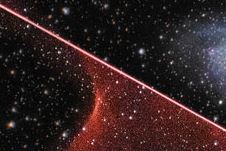by MarkBour » Fri May 03, 2019 4:10 am
Iksarfighter wrote: ↑Wed May 01, 2019 10:23 am
So nobody can confirm that this meteor is going from left to right.
Just a lot of bla bla bla...
It's a great question. I was hoping our forum contributors who have meteor expertise would give an answer. Unless it is truly something nobody can discern from a meteor track, which I very much doubt.
I would offer a few possible ways to get the answer:
- Cheat. Maybe Aman Chokshi knows. You could ask him on Instagram. I'm not going to make an Instagram account just to try to ask.
- Get the image data, look this up in some tool like Stellarium, perhaps you can determine a likely direction, especially if there was a known meteor shower with a radiant. But even if it is not in such a group, you might be able to tell which way is the ground and get a likely answer. What I know of this image, it seems to have been taken on 2019-04-08 at 9:06 pm, which I suppose is local time, and it may have been taken from Ladakh, India. Again, my sources are not very reliable here. I tried that in Stellarium and the Triangulum was below the horizon. You could try to ask Aman for more data to get that right.
- If the trail is visible in full, often some asymmetry will tell you which end is the terminal end. Here, the trail looks pretty symmetric in our view, but if there are any indications of the final end of the streak, they would almost have to be off the image to the left. So that is very weak evidence that it actually traveled right to left in the image. And that's my best guess, right there.
- Two things that do not seem to help:
- The shape of the wind-blown spreads is very interesting.

- Capture.JPG (17.16 KiB) Viewed 7680 times
- I also once thought you could probably make some deductions based on the colors in the track, but I guess this is quite unreliable, the color of a part of each track apparently depends on multiple factors.
.
So, I tried to address your question, but I don't know the answer. Perhaps it all came out as "bla bla bla" to you once again.
[quote=Iksarfighter post_id=291875 time=1556706231 user_id=143794]
So nobody can confirm that this meteor is going from left to right.
Just a lot of bla bla bla...
[/quote]
It's a great question. I was hoping our forum contributors who have meteor expertise would give an answer. Unless it is truly something nobody can discern from a meteor track, which I very much doubt.
I would offer a few possible ways to get the answer:
[list][*]Cheat. Maybe Aman Chokshi knows. You could ask him on Instagram. I'm not going to make an Instagram account just to try to ask.
[*]Get the image data, look this up in some tool like Stellarium, perhaps you can determine a likely direction, especially if there was a known meteor shower with a radiant. But even if it is not in such a group, you might be able to tell which way is the ground and get a likely answer. What I know of this image, it seems to have been taken on 2019-04-08 at 9:06 pm, which I suppose is local time, and it may have been taken from Ladakh, India. Again, my sources are not very reliable here. I tried that in Stellarium and the Triangulum was below the horizon. You could try to ask Aman for more data to get that right.
[*]If the trail is visible in full, often some asymmetry will tell you which end is the terminal end. Here, the trail looks pretty symmetric in our view, but if there are any indications of the final end of the streak, they would almost have to be off the image to the left. So that is very weak evidence that it actually traveled right to left in the image. And that's my best guess, right there.
[*]Two things that do not seem to help:
[list][*]The shape of the wind-blown spreads is very interesting.
[float=right][attachment=0]Capture.JPG[/attachment][/float]
I thought perhaps there was a characteristic, that the "forward" edge might always be the one to have that rounded asymptotic shape, or that the "trailing" edge might be. But I doubt it. I think this is just a feature of where the wind is stronger, and that it would be able to go either way. I won't even try to define which edge I meant by "forward" versus "trailing", since it doesn't matter, as long as I don't think this helps decide.
[*]I also once thought you could probably make some deductions based on the colors in the track, but I guess this is quite unreliable, the color of a part of each track apparently depends on multiple factors.
[/list][/list]
.
So, I tried to address your question, but I don't know the answer. Perhaps it all came out as "bla bla bla" to you once again.